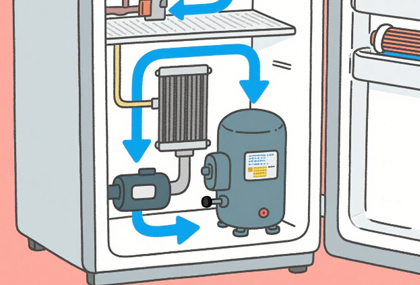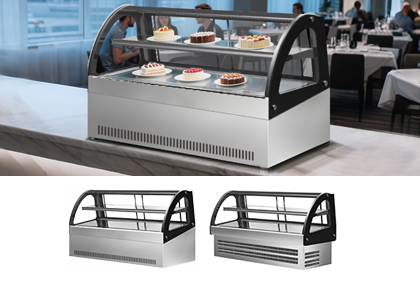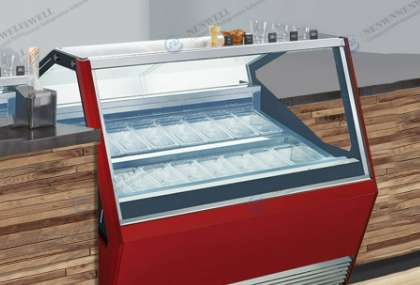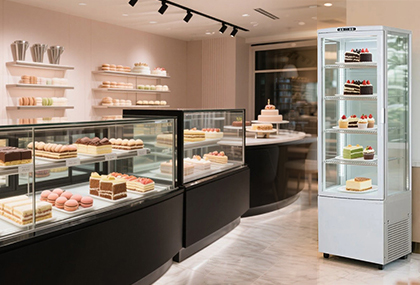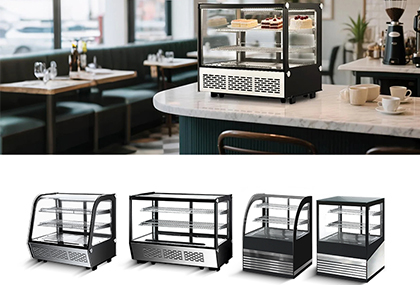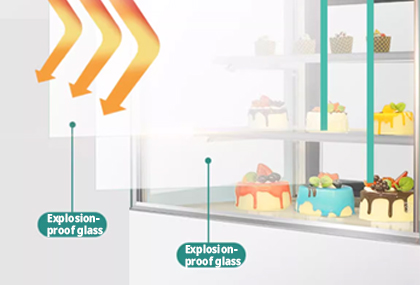What are the advantages of a room-temperature cake display cabinet?
The core value of room-temperature cake display cases lies in showcasing products, enabling the direct transmission of "product quality" and "brand philosophy." The design logic of these display cases is directly related to building trust in baking equipment.
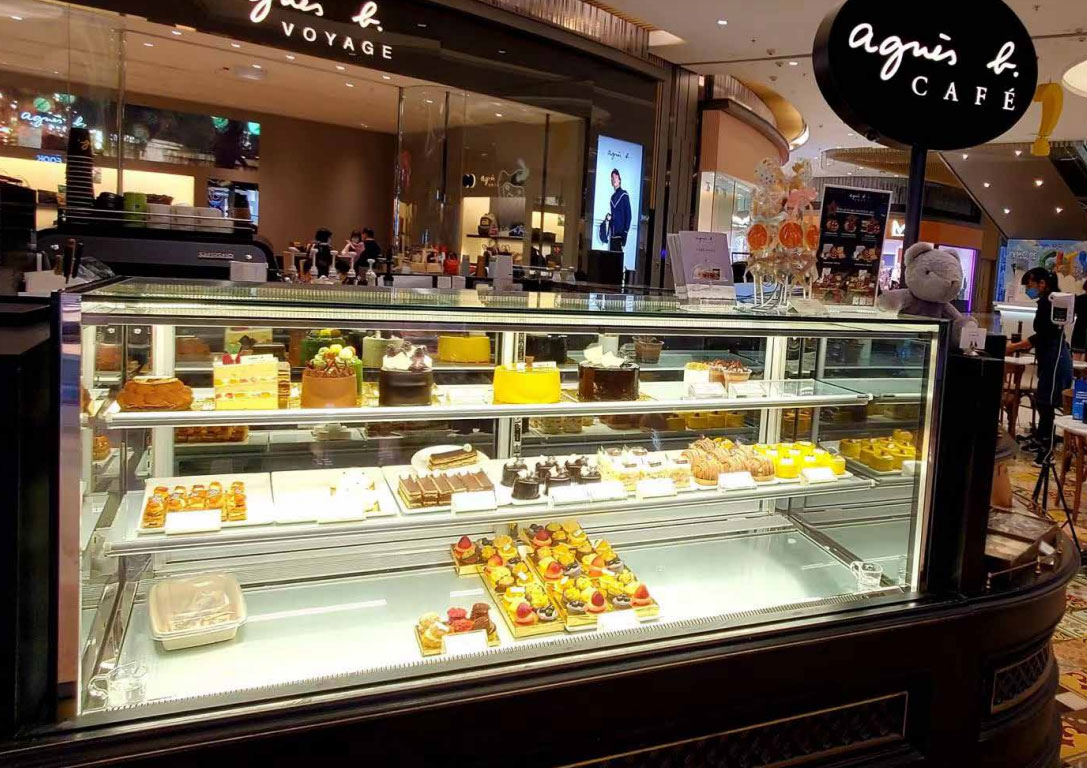
Professional room-temperature display cases predominantly feature a multi-layered transparent tempered glass structure, complemented by an adjustable shelf design. This allows for flexible adjustment of the display height according to the size of the cakes, such as sliced cakes, whole cakes, and cup cakes. The transparent design provides consumers with a clear view of the products. For instance, the fluffy texture of chiffon cakes, the delicate patterns of buttercream decorations, and the freshness of fruit toppings can all be clearly observed. This avoids the blurring of product information that often occurs with ordinary open shelves due to obstructions.
Meanwhile, the warm white LED light strips (usually with a color temperature of 3000K - 4000K) inside the display cases can restore the true color of the cakes, preventing issues like cream melting or color distortion caused by direct strong light. The deep brown luster of chocolate cakes and the vivid green base of matcha cakes can all be presented in the best visual effect through the combination of lighting and transparent glass. This emphasis on product details essentially conveys the brand's "confidence in its products."
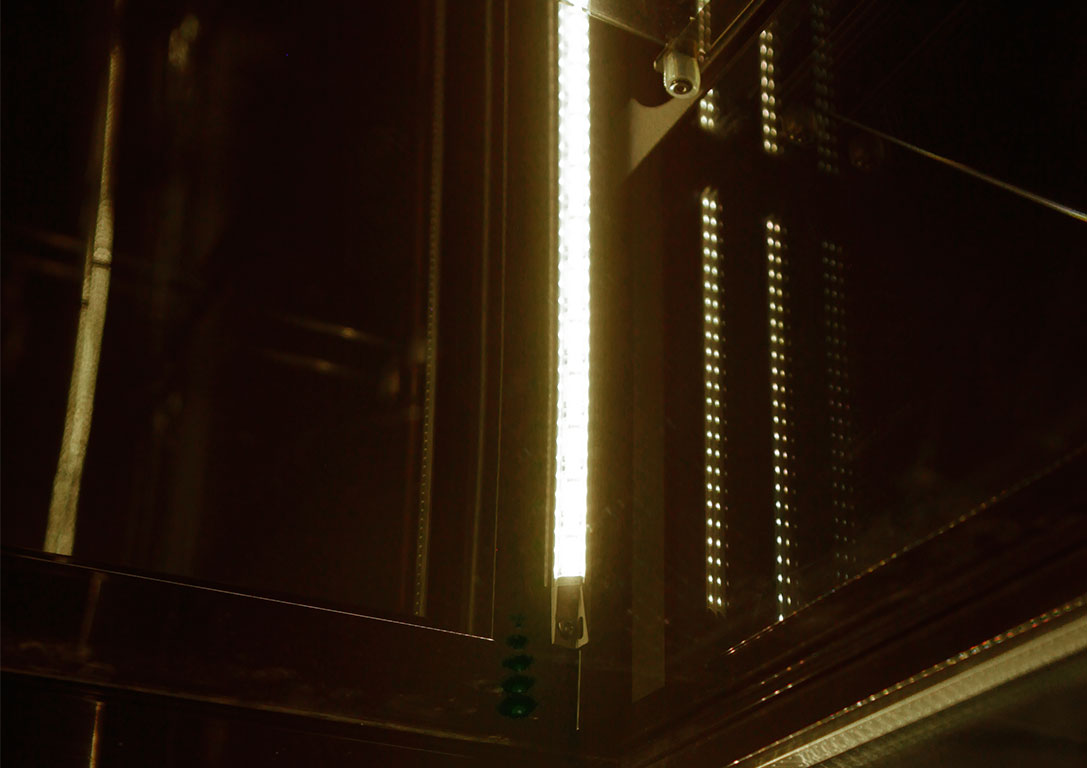
In terms of design style, room-temperature cake display cases can be adapted to the overall style of the store. For example, display cases with a Japanese minimalist style often feature white matte metal frames, transparent glass, which visually echo with wooden countertops and light-colored walls. For stores with a retro style, display cases with brass-textured frames can be selected to enhance the brand's retro tone.
Certainly, they can also leave a unique visual brand memory for customers. Especially for chain bakery brands, the standardized design of room-temperature display cases can become part of the brand's identification symbols.
In addition, the "enclosed display" of the cases also indirectly conveys the concept of hygiene. Compared with open display counters that are prone to contamination from dust, droplets, or hand contact, room-temperature display cases with a closed design effectively isolate external pollutants through magnetic glass doors and dust-proof seals. The balance between the "transparent visibility" on the outside and the "enclosed protection" on the inside demonstrates the brand's attention to food safety, which is a crucial detail in building brand trust.
Long-Term Operational Advantages of Avoiding High Power Consumption
The key difference between room-temperature cake display cases and refrigerated cake display cases lies in the absence of a refrigeration system, which gives the former significant advantages in terms of energy consumption and maintenance costs.
From the perspective of energy consumption, refrigerated cake display cases rely on components such as compressors, condensers, and evaporators to maintain a low-temperature environment of 5 - 10°C. The average daily power consumption is usually around 3 - 4 kWh (taking a 100L commercial refrigerator as an example). In contrast, room-temperature cake display cases only need to meet the basic requirements of lighting and ventilation (some high-end models are equipped with small fans to regulate the internal temperature and prevent local overheating), with an average daily power consumption of about 1.2 - 1.5 kWh, which is only one-third to one-half of that of refrigerated cases. Calculated at a commercial electricity rate of $0.16 per kWh, a room-temperature display case can save approximately (3 - 1.5) × 365 × $0.16 = $92 in electricity costs per year. If a store is equipped with 2 - 3 display cases, the annual electricity savings can exceed $140. Over the long term, this can effectively reduce the store's fixed operating costs.
In terms of maintenance costs, the refrigeration system is the core vulnerable component of refrigerated cases. The repair costs for problems such as compressor failures and refrigerant leaks usually range from $70 - $140 per incident, and the display case needs to be out of use during the repair period, affecting product display.
In contrast, the structure of room-temperature cake display cases is more simplified, with core components including only lighting strips, ventilation fans (if any), and the cabinet frame. The failure rate of these components is much lower than that of the refrigeration system. Daily maintenance mainly involves cleaning the glass and checking the brightness of the light strips, and does not require professional maintenance personnel, reducing the store's maintenance time and cost. Additionally, the service life of refrigerated cases is usually 5 - 8 years, while room-temperature display cases, due to the absence of high-load refrigeration components, can have a service life extended to 8 - 10 years, further reducing the store's equipment replacement frequency and capital investment.
It is important to note that the "low power consumption" of room-temperature cake display cases does not come at the expense of product preservation. The shelf life of room-temperature cakes (such as chiffon cakes, sponge cakes, pound cakes, etc.) is usually 3 - 7 days, and they can maintain their quality without the need for low-temperature refrigeration. The enclosed design and ventilation function of the display cases can meet their preservation requirements, avoiding energy waste caused by "excessive refrigeration." This design logic of "adapting to needs" is the core value of room-temperature display cases in cost control.
Practicality in Actual Operational Scenarios
In addition to brand image and cost control, the numerous detailed designs of room-temperature cake display cases can also solve practical pain points in store operations, improving operational efficiency from dimensions such as space utilization, display flexibility, and maintenance convenience. Their importance is reflected in the optimization of the adaptation to "people, products, and the store environment."
1. Space Adaptation: Modular Design Meets the Needs of Different Stores
The space requirements for display vary significantly among different types of stores. Small community bakeries may only need 1 - 2 independent display cases, while shopping mall counters or large bakeries require combined displays. Room-temperature cake display cases mostly adopt a modular design, supporting single-unit independent placement and multi-unit splicing (such as horizontally combined into a display wall or vertically stacked to save floor space). Some models also support embedded installation, which can be integrated into the store's countertops or walls, reducing the occupation of limited commercial space. For example, the room-temperature cake area in convenience stores is usually small. Embedded display cases can be integrated with the shelves next to the checkout counter, not only making use of corner spaces but also allowing consumers to easily view the products when checking out, enhancing the convenience of picking up items. This "space-friendly" design is particularly important in commercial scenarios where space is at a premium.
2. Display Flexibility: Adjustable Structure Adapts to Product Diversity
Room-temperature cakes come in a wide variety of types, with sizes ranging from 5cm sliced cakes to 20cm whole cakes, and the displayed products need to be adjusted according to the seasons (such as increasing mousse cups in summer and pound cakes in winter). The adjustable shelves (supporting vertical movement of 5 - 10cm) and detachable partitions of room-temperature display cases can quickly adapt to products of different sizes, eliminating the need to customize special display racks for specific cakes. For example, when a store launches a new product, "mini cup cakes," the shelf spacing can be reduced to 15cm for multi-layer dense display. When displaying whole cakes, some shelves can be removed to leave a height space of more than 30cm, preventing the top of the cakes from being deformed under pressure. This "one-case-for-multiple-uses" flexibility reduces the cost of replacing display tools due to product updates and makes display adjustments more efficient, without requiring additional manpower and time.
3. Maintenance Convenience: Easy-to-Clean Materials Reduce Operational Burden
In the daily operation of a bakery, the cleaning frequency of display tools directly affects food safety and the consumer experience. The cabinet materials of room-temperature cake display cases mostly use stainless steel liners (some use food-grade PP materials) and tempered glass. These materials have smooth surfaces and are not prone to oil and dirt adhesion. Cleaning only requires wiping with a damp cloth, without the need for special cleaning agents. The magnetic structure of the glass doors makes them easy to disassemble, allowing for regular deep cleaning to prevent dust accumulation at the edges of the glass. In contrast, due to the need to accommodate the refrigeration system, the liners of refrigerated cases have many gaps and pipes, making them more difficult to clean. Moreover, care must be taken to prevent cleaning agents from seeping into the refrigeration components, which could cause malfunctions. The "easy-to-clean" feature of room-temperature display cases can reduce the cleaning time of store staff (usually only 10 - 15 minutes per daily cleaning), enabling them to allocate more time to product production and customer service, indirectly improving operational efficiency.
4. Environmental Adaptation: Elimination of Condensation Improves the User Experience
Due to the temperature difference between the low temperature inside refrigerated cases and the ambient temperature outside, condensation easily forms on the surface of the glass doors. This not only affects the visual effect but may also cause water droplets to drip and contaminate the floor or products. In contrast, the internal temperature of room-temperature cake display cases is the same as the external temperature, eliminating the problem of condensation. This not only avoids blurring of the glass doors, which affects product viewing, but also reduces safety hazards caused by wet floors (such as consumers slipping). Although this is a small detail, in humid southern regions or during high-temperature summer environments, it can significantly enhance the store's usability and consumer safety.
From the brand perspective, the visual and stylized design of room-temperature cake display cases can convey product quality and brand tone, helping to build consumer trust. From the cost perspective, the design without a refrigeration system significantly reduces energy consumption and maintenance costs, relieving the store's operational pressure. From the functional perspective, the modular, flexible, and easy-to-maintain features adapt to different store scenarios, solving practical operational pain points. Room-temperature cake display cases are an indispensable infrastructure in the daily operation of the baking industry.
Most popular More «
-
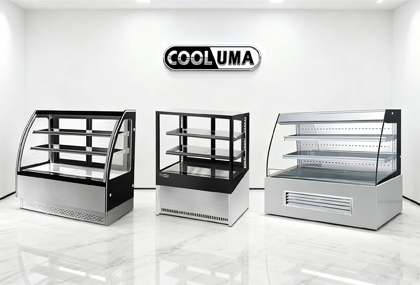
Which country is Cooluma a food display cabinet supplier brand from?
-
What are the advantages of a dual-airflow cake display cabinet?
-
Comprehensive Maintenance Guide for Cooluma Countertop Food Display Cabinets
-
How to solve the core pain points countertop display cases of bakery stores?
-
What is the price of a cake display cabinet in Mumbai?
-
Review of Pastry Countertop Display Cabinet T90C/T90S
-
What techniques are crucial for quality in glass cabinet manufacturing?
-
What are the models available for the Cooluma bread refrigerator with two shelves?
-
The Best Manufacturer of Commercial Italian Gelato Cabinets - Cooluma
-
What is the difference between 5 cake cabinets?





